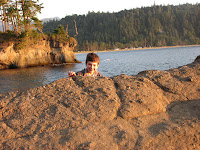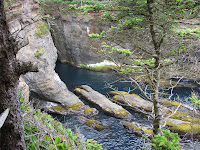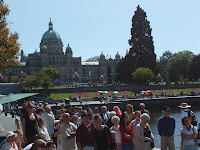I Need Civilization
“You can park in campsite #19 for tonight, then move to #20 for two nights. Sunday, you’d need to move again…or you can try to fit into #15. That campsite goes on a first-come-first-serve basis. You can stay there for up to 14 days – no reservation needed,” explained the Camp Host.
Hooking up and unhooking every 24 to 48 hours doesn’t appeal to us so we opted to take a look at #15. Ed paced the blacktop RV parking space. It wasn’t exactly 40 feet long. “Get ready for the show,” Ed called to some campers reclining in lawn chairs nearby. “I’m going to try to back my coach in here.”
Aware of the routine at Salt Creek Recreation Area, Denise offered up her lawn chair. “Here set the chair there to show you’re claiming the site,” she advised. “No one else will take the spot if they see a chair there.”
Years ago when I lived on a crowded city street, I staked out a parking place along Pittsburgh’s Semple Street with a lawn chair. This was the first time I had used a lawn chair to hold a campground site! Not wanting to buck local custom, I went with the strategic placement of the lawn chair as Ed began the arduous effort of taking the car off and disconnecting the tow dolly.
I had doubts that we’d fit in #15. Ed was determined to try. And, Denise’s husband optimistically said, “Give it a try. If you can’t fit, there’s always site #19. You might have to move around to stay for a few days. We did but it’s worth it in the end.”
Ed backed “Dolly’s Pride” in site #15 perfectly. The rear tires of the coach pressed tight against the concrete parking block. The back bumper grazed the grassy hillside. The front of the coach barely cleared the park road by an inch. We officially claimed site #15!
Amy at the Olympia National Park Visitor Center had recommended Salt Creek Recreational Area when I pressed her with a plea, “I need civilization for a few days. No wilderness parks. No hikes to mountains. I need a laundromat, a grocery store, Internet access, electricity, a post office, a bike shop, a car wash, and UPS shipping.” I ticked off this list as she knowledgeably marked a Port Angeles Chamber of Commerce street map showing the location of each.
“Our RV is 40-feet long. Can the park campgrounds accommodate our length?” I asked. “No, and none of them have electricity,” she replied as I groaned. “You need to try Salt Creek Recreation Area. I think it will meet your needs,” she added with a smile. I smiled then, and smiled even bigger when I wrote a check for four days in site #15 knowing I had the option to stay longer. Salt Creek Recreation Area has 92 campsites, 39 with utilities, and I had one of the ones with
utilities! We were 15-miles from Port Angeles and all the shops and services I requested. I had civilization. Yeah!! Better yet, I had a front row view over the rocky bluffs of the Strait of Juan de Fuca, a body of water separating the US from Canada. When I finished my chores, shopping and errands in town, I could relax and explore the coastline and the park.
My Tour Guide Was on Stick Duty
High tide sent waves of salty water crashing over the rocks at the base of the steps from Salt Creek’s campground. The bluffs glowed with the green mosses and seaweeds pressed to the coastline. Seagulls flew overhead and cruise ships moved across the far horizon. I took deep breaths of the salty air. Earlier in the day, a movie at the Olympic National Park Visitor Center reminded me why I love the coastal waters so much. It’s the eternity of the water. The waves never stop. The motion and sound are ever present. The shore is forever. I quietly enjoyed these thoughts then ascended the steps.
At the top of the steps, I found Denise’s 12-year-old son walking around, holding a fiberglass tip of a fishing rod. “Hey, did your Mom tell you I picked up some marshmallows, graham crackers and chocolate for her when I went to the store? Guess you have what you need to make some-mores.”
“Yes, thank you! That’s why I’m on stick duty,” he said holding up the fiberglass rod tip. “This won’t work over the campfire. I need some real sticks.”
 Then, we sort of fell into step together along the trail over top of the bluffs. He showed me the water caves where a bear probably lives and the rocky cliffs he had fearlessly explored earlier during
Then, we sort of fell into step together along the trail over top of the bluffs. He showed me the water caves where a bear probably lives and the rocky cliffs he had fearlessly explored earlier during
low tide. We admired the delicate lacey flowers blossoming on a tree. We descended some steps over the bluffs and poked at the
anemones in the tide pools.
Back on the high trail, we debated the merits of taking photos of certain trees and scenery. I took a few photos of him with the
waves as background to transfer later onto a disc and give to his Mom. Where a park sign marked the trail’s end, he showed me how to cut through some campsites to get to Tongue Point. We politely walked around some tent sites and dodged toddlers weaving their miniature bikes on the park road.

We climbed down more steps to the water’s rocky edge where waves crashed, driftwood bounced, and algae floated. I turned to take some photos; and, when I looked back, the kid was gone! For an instant, I wondered how I’d explain his disappearance to his Mom.
“Hey, where’d you go?”I yelled a bit sternly. Then, I saw the fiberglass rod tip pop over the edge of the rocks and I knew this fearless 12-year-old had climbed closer to the water’s edge. “Kid you scared me. Get up here!” I said with a nervous laugh. “Come on let’s head back. I’m getting cold wearing just these shorts and sandals. Maybe there’s a campfire ready for those some-mores you plan to make.”
 We never did find any decent sticks for marshmallows while on “stick duty”; but I came away with something more precious. My new friend gave me a delightful tour of Salt Creek Recreation Area through the eyes of a 12-year-old. Back at site #15, I loaned my new friend a metal pronged roasting stick, he returned it to me in better condition than I gave it to him, just as my walk turned out better than expected.
We never did find any decent sticks for marshmallows while on “stick duty”; but I came away with something more precious. My new friend gave me a delightful tour of Salt Creek Recreation Area through the eyes of a 12-year-old. Back at site #15, I loaned my new friend a metal pronged roasting stick, he returned it to me in better condition than I gave it to him, just as my walk turned out better than expected.
A Taste of Patriotism: My First Bunker, My First American Bald Eagle

Patriotism is infrequently on my mind, yet during our visit to Salt Creek Recreation Area two things triggered a taste of patriotism.
I saw my first bunker on US soil and my first American Bald Eagle.
Remnants of World War II-era Camp Hayden are tucked away in a hillside where deer roam now, and in the surf below, swimmers
brave the chilly water of the Strait of Juan de Fuca. The military presence of guns and the 150 soldiers once housed here are long gone. A kiosk explains that two 16-inch guns defended this waterway against enemy aggression, but they were only fired several times for practice. The 45-foot long monster gun could fire could fire a one-ton projectile 28 miles. It was never discharged. The red projectiles inside the tunnels of the bunker are similar to those used in WWII. These historic remnants are the reality, traces of US defenses to preserve our freedoms.

While missiles, guns, and bunkers are the reality, the American Bald Eagle represents the ideal of freedom. An eagle soared against a misty morning sky over the Strait landing on a barren branch of the giant pine. He had the freedom to glide over the whitecaps, freedom go beyond the cliff of the rugged coastline, and freedom to perch watchfully over the US coast.
July 24 – 28, 2008
Salt Creek Recreation Area - Clallam County Parks
West of Port Angeles, Washington; from Hwy. 112, turn north onto Camp Hayden Rd. Travel approximately 3-1/2 miles to the park entrance on the right.

























 In that minute or so, I looked around. Three strips of fly tape covered with dead flies hung from the frosted window. Long and short eagle feathers stood in a line of what looked like pre-cut holes drilled into the wooded window frame. More eagle feathers stood like quill pens in a wooden mount on the wall behind Kimm, with two m’s. Round canisters of garlic salt lined the shelves above a stack of paper plates. A sign read “Free Samples.”
In that minute or so, I looked around. Three strips of fly tape covered with dead flies hung from the frosted window. Long and short eagle feathers stood in a line of what looked like pre-cut holes drilled into the wooded window frame. More eagle feathers stood like quill pens in a wooden mount on the wall behind Kimm, with two m’s. Round canisters of garlic salt lined the shelves above a stack of paper plates. A sign read “Free Samples.”



























